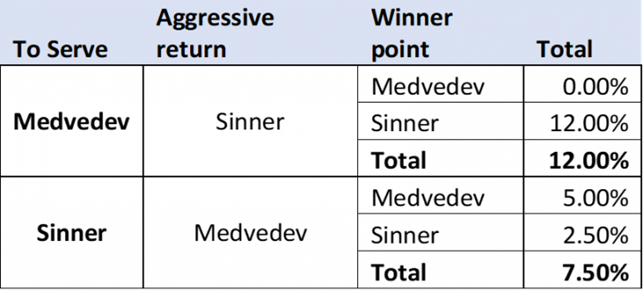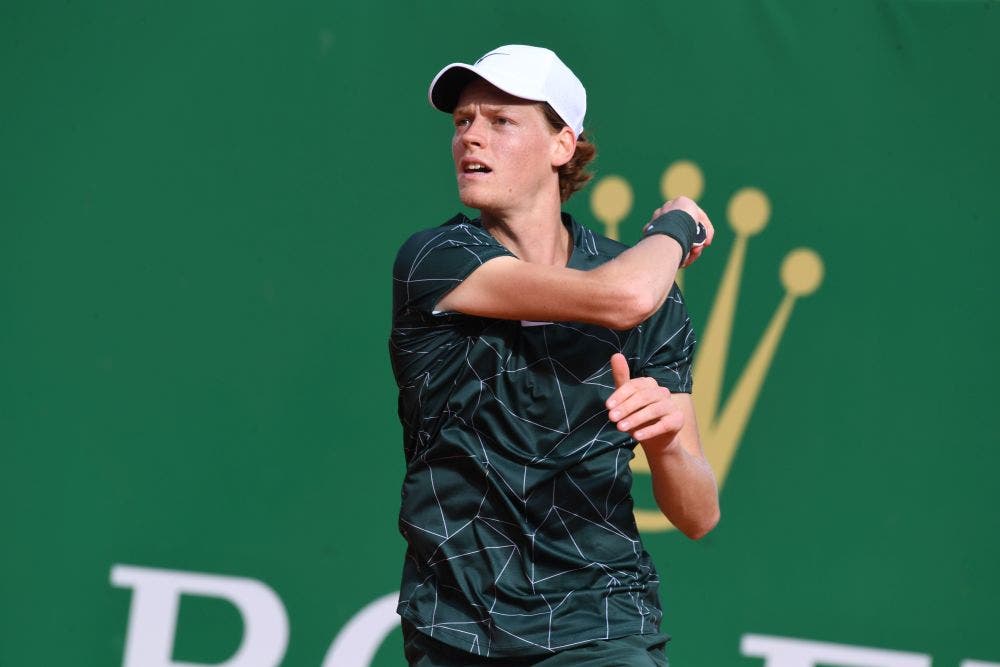By Federico Bertelli
Sunday’s match was a sort of maturity test for the Italian player, who was beaten but showed that he is on the right track. The problem, however, is that overthrowing a top 5 player who plays at his best, is still a tall order.
General overview: once again, we take this opportunity to present our own elaboration of the main dimensions of analysis regarding service and return:
1st_in – percentage of first serves in
1st_won – percentage of points won on first serves
2nd_won – percentage of points won on second serves
Bp_saved – percentage of break points saved
Bp_converted – percentage of break points converted
1st_ret_won – percentage of points won on return of opponent’s first serve
2nd_ret_won – percentage of points won on return of opponent’s second serve
Pt_won – percentage of total points won
Ret_won – percentage of points won on return Srv_won – percentage of points won on serve

The advantage of this visualization is that it allows us to immediately see the dominance of one player over the other for the various dimensions of analysis. What we see first and foremost is how much of the difference was made by Medvedev’s ability to increase the percentage of first serves in after the first set. At this level, a gap of more than 12% in first serves in is a considerable handicap, so hats off to Medvedev for shifting a couple of gears in his game. It is interesting to note that Jannik was able to match Medvedev’s performance on second serves; in fact, this is an extremely comforting data point considering the quality of the Russian player’s rallies and the fact that the match often played out in extended rallies. Of course, this is a big improvement for Sinner compared to last Sunday’s match against Cressy.
Service directions: based on the charting provided at the end of the article, we have graphically represented the serving choices of the two players:
The graphs can be read as follows: the blue arrows represent the directions of serves from the even court side (with the players serving from right to left). The yellow arrows represent the directions of serves from the odd court side (with the players serving from left to right). The thickness of the arrow visually indicates how much a certain direction was chosen over the other. The values are expressed in percentage, with the service area divided into 6 zones:
Servicesonthe deuce side
Wide serves Body serves T Serves Servicesonthe advantage side
Wide serves Body serves T Serves With reference to the choices on the first serve, we have fairly similar predictions, except for the distribution of the wide serve on the even side. In this case, Medvedev had a greater intent in seeking the open angle.

On the second serve, Sinner’s choice was mainly to go for a kick serve with a central bounce, with the aim of giving Medvedev few angles to respond with. On his part, the Russian favoured a greater search for the outer angles in his second serve. In terms of the efficiency of their choices, we can see that Sinner could have favoured the first serve going wide on the even side more, while in general, he had difficulty taking Medvedev out of position on the advantage side. In this situation, the Russian was very good at handling Sinner’s outer serves and starting long exchanges. On the other hand, Medvedev was able to construct advantageous situations on his first serve, often using variations of serves to the centre and to the wide side.

Return performance: Both players were extremely conservative, as they rarely tried to enter aggressively on the opponent’s second serve. In particular, when Medvedev served a second serve, Sinner was aggressive on only 12% of occasions and he won the point in all those instances. The problem for the Italian was that Medvedev’s second serves with less pace were really few, so the window of opportunity was rather slim. However, as the match progressed and with the increasing pressure imposed by the Moscow native, a solution could have been to try going for outright winners with more aggressive returns. This could be a key to Jannik’s future development, the ability to attack his opponent’s second serve. On the other hand, Medvedev always positioned himself calmly at the back of the court, grinding out points and minimizing Sinner’s chances to hit winning serves.

The graphic of the Russian’s position in response, both on the first and second serve, is particularly telling in this regard:


Sinner, on the other hand, had a more proactive approach, both on the first and second serve, but unfortunately, as we have seen, it did not translate into a greater ability to take control of the point from the return.


Length of rallies: it’s worth noting how this was a particularly intense match for indoor standards; compared to a match like last week’s between Cressy and Sinner, in which the prevalence of short rallies was clear, Sunday saw a completely different context:



The distribution is quite clear: Sinner was able to keep up with Medvedev in extended rallies, which is not at all obvious against a player of such tactical and physical skills as Medvedev. However, the Russian was able to demonstrate greater efficiency on his first serve, which allowed him to slam the door in Sinner’s face. Particularly emblematic was the sixth game of the second set, where Sinner found himself in the rare situation of having three consecutive break points, but Medvedev was able to produce a series of six consecutive first serves, which allowed him to dig himself out of the hole.
Conclusions: The big difference was made by Medvedev’s ability to elevate his quality on serve, a weapon that Sinner still does not possess at the same level. Or rather, Sinner’s serve works, but not yet at the level of the world tennis elite; and having the possibility to have a greater impact and close points more quickly in the long run can prove to be a determining factor, especially in Slam tournaments.






